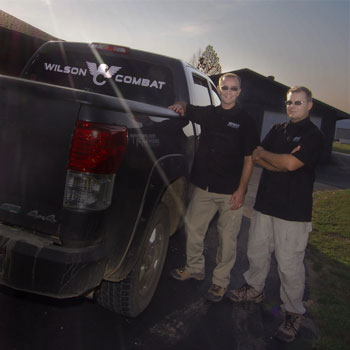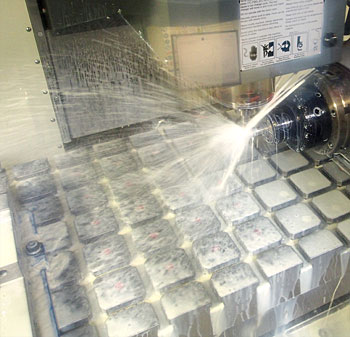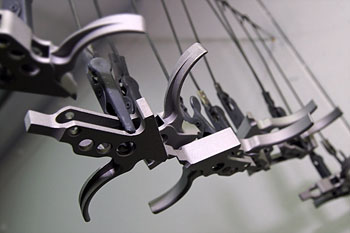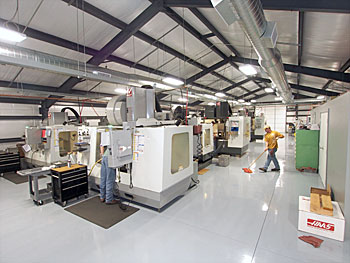 What makes a Wilson Combat a Wilson Combat? It’s more than just another roll mark. Many people know Bill Wilson for setting highest standards in the 1911 pistol genre, fewer know much about their rifles. SHWAT™ Founders Stephen and Jonathan were invited to hog hunt with Wilson Combat President Bill Wilson for a couple of days at the Circle WC Ranch in Texas, followed by a factory tour from Vice President Ryan Wilson at their facility in Arkansas. We’ll tell you about the hunt later, but let’s take a look at what makes the guns legendary.
What makes a Wilson Combat a Wilson Combat? It’s more than just another roll mark. Many people know Bill Wilson for setting highest standards in the 1911 pistol genre, fewer know much about their rifles. SHWAT™ Founders Stephen and Jonathan were invited to hog hunt with Wilson Combat President Bill Wilson for a couple of days at the Circle WC Ranch in Texas, followed by a factory tour from Vice President Ryan Wilson at their facility in Arkansas. We’ll tell you about the hunt later, but let’s take a look at what makes the guns legendary.
That Wilson Combat is a premium brand in the firearms world is a given. Sure, the tolerances are great, they are buttery smooth, and the finish looks fantastic. But is there more to it? Having spent the afternoon with Ryan Wilson at the factory, we’re satisfied the answer is a resounding “yes!” This isn’t just another rifle review. Let us tell you what we learned.
Most would agree that in order to excel in any manufacturing endeavor, it’s takes a combination of the right people, tools, materials, and facilities. Drop any one of these, and everything gets compromised.
Let’s start with the people who make up Wilson Combat. Walking the floors of the various buildings at the Wilson Combat headquarters, we talked with a number of them. Everyone we spoke with was proud to be a part of the Wilson Combat organization. They were enthusiastic about showing us what they did and how they did it. The stats verify that what we saw was legitimate: half the employees been there seven years or longer. A good number of them started out with founder Bill Wilson more than twenty years ago. That’s an indicator of a well run company, but it goes beyond that. Beyond the pride of being a part of the Wilson Combat organization, everyone we talked with clearly took pride in individual work. This was universally true with each person we spoke with, regardless of the role in the company. Less tenured folks spoke highly of the more tenured, expressing ambitions to reach same levels of mastery as the more tenured.

That commitment to quality starts at the parts level. For example, take a look at their Tactical Trigger Unit for AR-15 rifles. I’ve owned and used the TTU since long before SHWAT™ was launched, but my appreciation for what goes into these definitely went up. Each one is hand assembled and tested by Steve Johnson. Steve tests each trigger 50-100 times for pull weight (done mechanically on a scale to confirm weight and consistency), feel, and safety. And that’s just one part that is standard on a Wilson Combat AR-15. Other unique features include their TRIM Rail (something we plan a full review of later), and their Accu-Tac flash hider. To ensure quality and production, Wilson makes a lot of its parts in house on the eight mills, five lathes, and two wire EDM machines.
Rifle department manager Jim Watson clearly loves his job and the responsibility that goes with it. We interrupted his work on a new assembly. He described the process of building a new AR to the Wilson Combat standards. It starts with forged 7075-T6 upper and lower receivers. Rather than simply grabbing one of each necessary part to build an AR-15 and then assembling them, they hand pick and hand fit each part for that individual rifle. Jim says, “Best fit gives best function. Best function gives best accuracy.” The hogs we shot with a Wilson AR would seem to agree with that assessment, but more on that next time.

Adding to the quality and feel of the rifle, and in this case the simplicity of cleaning, Wilson Combat uses an NP-3 plated bolt carrier assembly. Much has been made of various coatings in the industry. Suffice it to say that the rifles avoid the level of carbon build up generally associated with the gas impingement system, and function smoothly. Yes, they function smoothly, and I’ve now written something like that several times. It’s part of the over all equation that makes a Wilson Combat what it is. When I used to read lines like that, I thought, “Whatever… You’ve seen one, you’ve seen them all.” Not true, but you’ll have to see for yourself.
 We also talked with Brandon Collier who heads up Wilson’s finish shop. He walked us through the entire process. Once again, the attention to detail stood out. Wilson Combat uses the Armor Tuff® finish on their guns. This finish from Wilson is very highly regarded by those who’ve studied it. It looks amazing, but that’s just for starters. This highly durable finish bonds to the surface material, providing corrosion resistance and lubricity.
We also talked with Brandon Collier who heads up Wilson’s finish shop. He walked us through the entire process. Once again, the attention to detail stood out. Wilson Combat uses the Armor Tuff® finish on their guns. This finish from Wilson is very highly regarded by those who’ve studied it. It looks amazing, but that’s just for starters. This highly durable finish bonds to the surface material, providing corrosion resistance and lubricity.
Consistent quality requires consistent testing. Each Wilson firearm is carefully fitted together by hand then test fired. Rifles are fired twenty times if they produce a good test target the first time. Pistols are fired seventy times if their first test target is good.
So, what makes a Wilson Combat a Wilson Combat? Generations sharing the same commitment to quality secured by unique innovation, state of the art tooling, and master craftsmen who love their trade and company. Then there’s the piece that no one can ever duplicate: It’s a three generation family business, founded by the legendary Bill Wilson, President and CEO. Vice President Ryan Wilson started by out taking out the trash and doing other miscellaneous jobs when he was just a kid. So maybe it’s not quite a third generation company yet, but we did meet Ryan’s young son who occupied some space at the VP’s desk. Find a Wilson Combat Rifle and run it. You’ll know instantly it’s not your average sporting goods store rifle.
On the Web:
Wilson Combat: www.wilsoncombat.com


Thanks so much for your stand to not sell anything to California law enforcement agencies that you can’t sell to law abiding citizens of this state. I’ve lived here for 40 years and worked as a registered nurse for 35 years here. I thought this was the greatest place on earth to live until the last 10 years. It’s turned out to be the worst place.
Thanks to people like you and Ronnie Barrett, you guys truly make a difference. Wish I would have bought one of your .45’s before it was to late. God bless. Keep up the good fight.
Sincerely
Mark Hudson RN